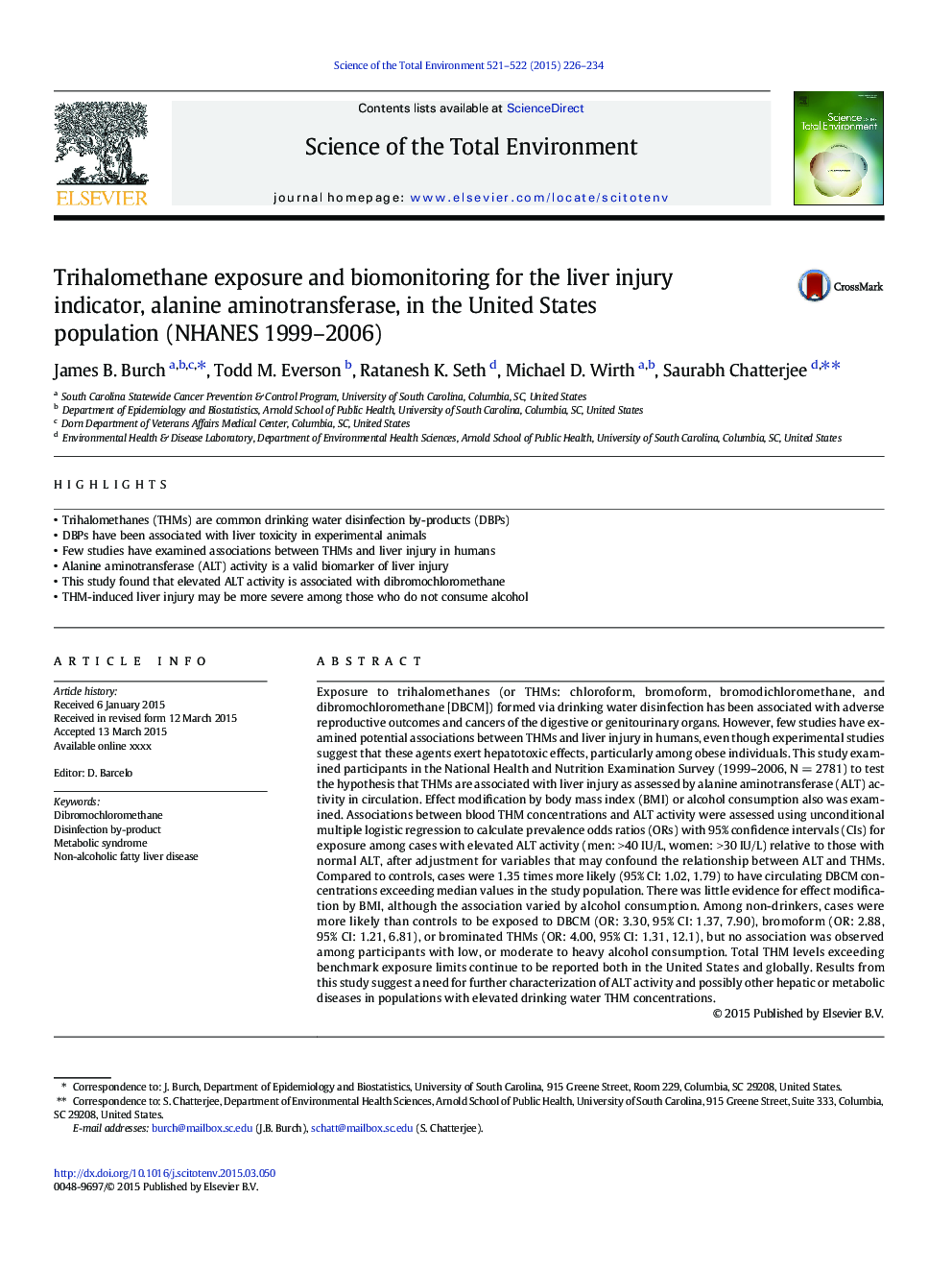| کد مقاله | کد نشریه | سال انتشار | مقاله انگلیسی | نسخه تمام متن |
|---|---|---|---|---|
| 6326595 | 1645536 | 2015 | 9 صفحه PDF | دانلود رایگان |
عنوان انگلیسی مقاله ISI
Trihalomethane exposure and biomonitoring for the liver injury indicator, alanine aminotransferase, in the United States population (NHANES 1999-2006)
دانلود مقاله + سفارش ترجمه
دانلود مقاله ISI انگلیسی
رایگان برای ایرانیان
کلمات کلیدی
موضوعات مرتبط
علوم زیستی و بیوفناوری
علوم محیط زیست
شیمی زیست محیطی
پیش نمایش صفحه اول مقاله

چکیده انگلیسی
Exposure to trihalomethanes (or THMs: chloroform, bromoform, bromodichloromethane, and dibromochloromethane [DBCM]) formed via drinking water disinfection has been associated with adverse reproductive outcomes and cancers of the digestive or genitourinary organs. However, few studies have examined potential associations between THMs and liver injury in humans, even though experimental studies suggest that these agents exert hepatotoxic effects, particularly among obese individuals. This study examined participants in the National Health and Nutrition Examination Survey (1999-2006, NÂ =Â 2781) to test the hypothesis that THMs are associated with liver injury as assessed by alanine aminotransferase (ALT) activity in circulation. Effect modification by body mass index (BMI) or alcohol consumption also was examined. Associations between blood THM concentrations and ALT activity were assessed using unconditional multiple logistic regression to calculate prevalence odds ratios (ORs) with 95% confidence intervals (CIs) for exposure among cases with elevated ALT activity (men: >40Â IU/L, women: >30Â IU/L) relative to those with normal ALT, after adjustment for variables that may confound the relationship between ALT and THMs. Compared to controls, cases were 1.35 times more likely (95% CI: 1.02, 1.79) to have circulating DBCM concentrations exceeding median values in the study population. There was little evidence for effect modification by BMI, although the association varied by alcohol consumption. Among non-drinkers, cases were more likely than controls to be exposed to DBCM (OR: 3.30, 95% CI: 1.37, 7.90), bromoform (OR: 2.88, 95% CI: 1.21, 6.81), or brominated THMs (OR: 4.00, 95% CI: 1.31, 12.1), but no association was observed among participants with low, or moderate to heavy alcohol consumption. Total THM levels exceeding benchmark exposure limits continue to be reported both in the United States and globally. Results from this study suggest a need for further characterization of ALT activity and possibly other hepatic or metabolic diseases in populations with elevated drinking water THM concentrations.
ناشر
Database: Elsevier - ScienceDirect (ساینس دایرکت)
Journal: Science of The Total Environment - Volumes 521â522, 15 July 2015, Pages 226-234
Journal: Science of The Total Environment - Volumes 521â522, 15 July 2015, Pages 226-234
نویسندگان
James B. Burch, Todd M. Everson, Ratanesh K. Seth, Michael D. Wirth, Saurabh Chatterjee,